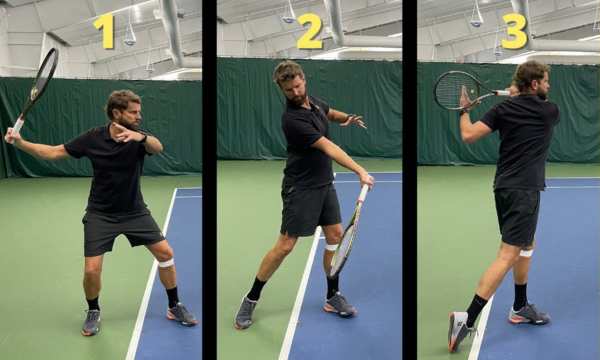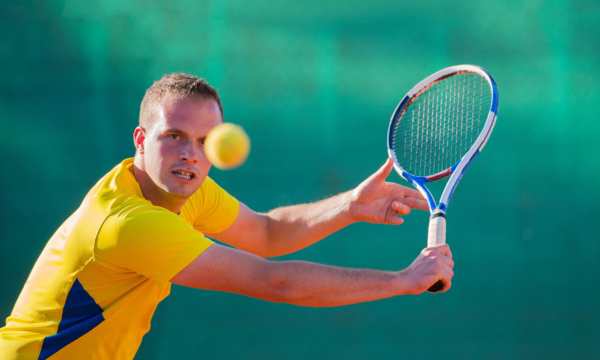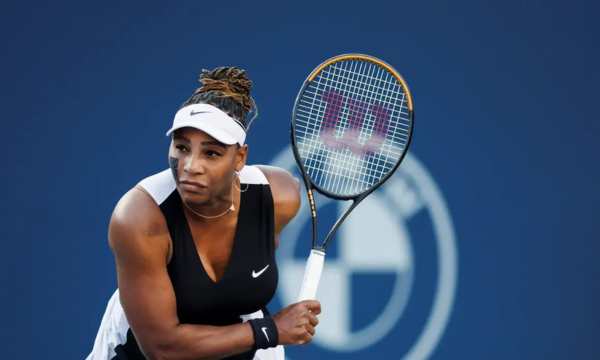Tips to Master the Best Tennis Shots
The most efficient tennis shots combine refined technique, intelligent strategy, and precise execution under pressure.
Anúncios
Mastering this set of skills completely transforms your performance on the courts, elevating your game to another level.
Both beginners and experienced players always have aspects to improve in their shots.
In today’s article, we will explore everything from the essential fundamentals to advanced techniques that will make you rethink your approach to the game and develop a complete repertoire of efficient shots.
The Three Pillars Every Tennis Player Must Master
To build a solid game, the fundamental tennis shots need to be developed with meticulous attention to technical details.
The first essential pillar is consistency, the foundation for all other skills in the sport. Practicing the same shot repeatedly until it becomes automatic is the path to excellence in tennis.
The second crucial pillar is body positioning, often neglected by amateur players. Proper posture allows you to execute shots with balance and power, saving energy during matches.
The early preparation of the body determines the quality of the technical execution of each stroke. The third fundamental pillar is footwork, the true differentiator between technical levels in tennis.
Getting into the ideal position for each ball allows you to transform defensive shots into offensive ones naturally.
The best players are always in motion, constantly adjusting their position in relation to the ball.
Developing these three fundamental pillars significantly expands your repertoire of effective strokes.
Mastering the Forehand: From Consistency to Power
The forehand is often the most natural shot for many tennis players, but perfecting it requires attention to specific details.
Efficient forehand tennis shots start with a proper grip, typically semi-western for most modern players.
Early racket preparation is essential to allow enough time to adjust to the ball. Weight transfer during the forehand transforms mediocre strokes into powerful ones.
Start with the weight on the back foot and transfer it to the front foot during impact. The rotation of the hips and shoulders generates the true power of the shot, not just the arm strength.
The ideal contact point for the forehand is slightly in front of the body and beside the hip. In topspin shots, the racket should accelerate from low to high with a motion similar to “brushing” the ball.
The full follow-through after impact ensures power and control. Versatility in the forehand allows you to adapt your tennis shots to different game situations.
A consistent forehand is your main shot to control points and create offensive opportunities.

Forehand-Steps-(Source-Google)
How to Enhance Your Serve with Precision
The serve represents the only tennis shot where you have complete control, without direct influence from the opponent.
A good serve starts with foot positioning and how you hold the ball. The ball toss technique directly influences the effectiveness of serve shots.
The toss should be consistent, reaching sufficient height to allow full arm extension. The toss position varies depending on the type of serve you want to execute.
The pendulum motion of the racket should be fluid, using the whole body synchronously. Powerful serve shots involve knee flexion followed by vigorous leg extension.
The rotation of the hips and shoulders enhances the racket acceleration at the moment of impact. Types of serves to diversify your shots:
- Flat serve: maximum speed, less margin for error, direct trajectory.
- Slice serve: lateral spin, curved trajectory, effective for pushing the opponent off the court.
- Kick serve: high bounce and upward spin, difficult to return, ideal as a second serve.
- Serve and volley: tactic of approaching the net after a strategically positioned serve.
Developing variation in serve types enriches your repertoire and makes it difficult for the opponent to position for the return.
Net Play: Improve Your Volley and Smash
Tennis shots near the net require quick reflexes and precise technique, being significant differentiators for ambitious players.
Effective volleys are executed with short and firm movements, unlike baseline strokes. The slightly modified continental grip favors greater control and versatility.
Body positioning is crucial for net shots. Keep your knees bent, weight slightly forward, and racket prepared in front of you.
Anticipation and reading the game determine the success of these offensive interventions at decisive moments.
For the smash, considered one of the most intimidating tennis shots, correct timing makes all the difference.
Position yourself under the ball with your body sideways, similar to the serve position. The shot should be executed at the highest possible point, with full arm extension.
Net tennis shots are essential to finish points built with intelligence. Players who master these techniques can shorten rallies and save energy in long matches.
Tips for Special Shots That Surprise Opponents
The advanced repertoire of tennis shots includes special strokes that, when executed at the right moment, can completely destabilize the opponent.
The drop shot, a short ball with little reach, is particularly effective against opponents positioned at the baseline.
The key to a good drop shot is disguise, suggesting a normal stroke until the last moment. The defensive lob turns unfavorable strokes into counter-attack opportunities.
When executed with precision, it lifts the ball over the opponent who has advanced to the net. The offensive lob combines height and spin, making recovery difficult even for well-positioned players.
The slice backhand, one of the most versatile tennis shots, keeps the ball low and reduces its pace.
This shot forces the opponent to generate their own power and creates challenging angles. The underspin effect of the slice produces a floating trajectory that can be tricky on different surfaces.
These advanced tennis shots should not be the basis of your game but strategic complements.
The ideal time to use them is when the element of surprise can mentally unbalance the opponent or resolve a specific tactical situation.

Special-plays-(Source-Google)
Defensive Plays That Save Impossible Points
In unfavorable situations, well-executed defensive tennis shots can completely reverse the course of a point.
The ability to turn defense into attack distinguishes great players. The defensive slice is essential when under pressure, as it buys time for positional recovery.
The passing shot represents one of the most rewarding tennis shots, executed when the opponent advances to the net.
The technique requires precision under pressure and the ability to find narrow angles. The choice between a parallel or cross-court passing shot depends on the opponent’s position.
Defensive tennis shots require patience and mental resilience. Accepting the defensive position momentarily, without attempting premature winning shots, often leads to regaining control of the point.
How to Improve Doubles Shots
Doubles tennis shots require significant technical and tactical adaptations compared to singles play. Effective communication between partners becomes as important as shot execution.
Establishing clear signals for specific shots avoids confusion and hesitation during quick exchanges. Coordinated positioning is fundamental for successful doubles tennis shots.
The classic formation (one at the net, one at the baseline) and the Australian formation (both on the same side) have specific advantages depending on the point context. Intelligent alternation between these formations confuses opponents.
The cross-court volley represents one of the most effective doubles tennis shots, targeting the opponent positioned at the baseline.
The middle volley, directed between the two opponents, creates confusion about who should intercept the ball.
These tactics exploit the uncertainties of the opponent’s communication. Well-coordinated doubles tennis shots provide great satisfaction and tactical efficiency.
What We Can Learn with the Professionals
Analyzing the tennis shots executed by professionals offers valuable insights for players of all levels.
Each great champion has a distinctive technical element that we can incorporate into our game.
Federer’s forehand, Djokovic’s backhand, and Serena Williams’ serve represent models of technical excellence.
Mental preparation for decisive tennis shots differentiates champions from mere competitors.
Observe how professionals maintain their routine and concentration at critical moments. Controlled breathing, routines between points, and emotional resilience are aspects replicable even for amateur players.
The tactical construction of points by professionals reveals how tennis shots connect in logical sequences. We rarely see isolated strokes without a clear strategic purpose.
Each ball prepares the next, progressively creating positional advantages or forcing the opponent into uncomfortable movements.
Conclusion
Mastering the various tennis shots presented in this article requires dedication, patience, and deliberate practice.
The balanced combination of offensive and defensive shots, along with tactical intelligence in choosing the right moment for each technique, will form a complete tennis player adaptable to different opponents and conditions.
Stay patient during the learning process, celebrate small achievements, and, above all, preserve the joy of playing this fascinating sport.The most efficient tennis shots are those you can execute with confidence under pressure, so find your own style while incorporating the correct technical principles.
FAQ
How to better read the opponent’s intentions to anticipate shots?
How to overcome nervousness in important points?
What exercises can I do at home to improve my volley?
How to adapt my game to different court surfaces?
Is there any recommended routine to improve concentration between important points?
 WTA Tennis: A Complete Guide to the Current Women’s Circuit
WTA Tennis: A Complete Guide to the Current Women’s Circuit
WTA: the circuit that revolutionized women’s tennis worldwide! Anúncios This professional circuit has transformed athletes into global icons and redefined standards in women’s sports. Each season, […]
Keep reading Learn All About the ATP: The Elite of Men’s Tennis in 2025
Learn All About the ATP: The Elite of Men’s Tennis in 2025
Discover how the ATP has transformed men’s tennis into a professional and highly competitive global circuit. Anúncios Today, the Association of Tennis Professionals represents the pinnacle […]
Keep reading Serena Williams: The Journey and Records of the Tennis Legend
Serena Williams: The Journey and Records of the Tennis Legend
Serena Williams transformed women’s tennis with a powerful playing style that we had never witnessed on professional courts. Anúncios More than an extraordinary athlete, she became […]
Keep reading